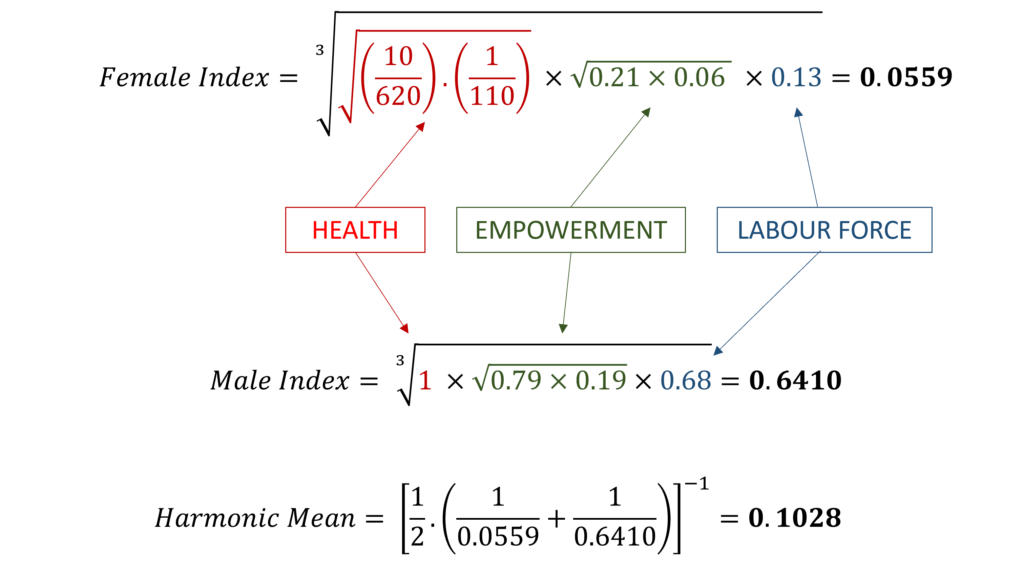The United Nations Development Programme (UNDP) introduced the Gender Inequality Index (GII) as a composite measure to assess gender disparities in various dimensions. It is part of the broader framework of the Human Development Index (HDI) and provides insights into gender-based inequalities. The Gender Inequality Index reflects how women face disadvantages and discrimination compared to men. The Gender Development Index (GDI) focuses on gender gaps in development. On the other hand, the GII is more comprehensive in its focus on inequality and discrimination.
The GII is calculated based on the following three dimensions:
- Reproductive Health: This dimension includes two indicators: maternal mortality and adolescent birth rates. It assesses women’s reproductive health and their access to maternal care.
- Empowerment: The empowerment dimension considers two indicators: the percentage of parliamentary seats held by each gender and the percentage of women aged 25 and older with at least some secondary education. This dimension provides insights into women’s political representation and educational attainment.
- Labor Market Participation: This dimension measures the percentage of women and men aged 15 and older engaged in paid employment. It reflects gender disparities in economic opportunities and employment, indicating women’s participation in the labour market.
The GII index ranges from 0 to 1, with higher values indicating greater gender inequality. A GII value of 0 represents perfect gender equality, while a value of 1 indicates maximum inequality.
Econometrics Tutorials with Certificates
History of GII
The GII was first included in the Human Development Report in 2010. We can understand its development by considering the following key points.
- Proposal and Development (2009): The development of the GII began before its official inclusion in the 2010 Human Development Report. The authors put forth a proposal for a new gender-specific index to address limitations in existing measures and provide a more nuanced understanding of gender inequality.
- Inaugural Inclusion in the Human Development Report (2010): The GII made its debut in the 2010 Human Development Report, alongside the Human Development Index (HDI). This marked a significant step toward incorporating gender-specific indicators into the broader framework of human development.
- Rationale for GII: The motivation for introducing the GII stemmed from recognizing that existing gender-related indices, such as the Gender Development Index (GDI), had limitations in capturing the complexity of gender inequalities. The GII aimed to address these limitations and provide a more comprehensive assessment.
- Subsequent Updates and Refinements: Since its introduction, the GII has undergone updates and refinements to improve its accuracy and relevance. These adjustments may include changes in the choice of indicators, normalization methods, or other aspects of the calculation.
- Global Monitoring and Policy Implications: The GII globally monitors progress in gender equality and guides policy discussions. It serves as a tool for policymakers, researchers, and advocates to identify areas of concern and implement targeted interventions to address gender disparities.
Calculation of the Gender Inequality Index (GII)
The GII is calculated using a formula that includes three key dimensions: reproductive health, empowerment, and labour market participation. It uses different types of means such as the geometric and harmonic mean to normalize the indicators. Since its introduction in 2010, the calculation of GII has seen some changes and updates. Here, we will illustrate the calculation of the GII as seen in the Human Development Report of 2021-22. Therefore, we will not discuss the older versions of the index.
To illustrate, let us consider a hypothetical example with the following values of indicators:
| Dimension | Indicator | Female | Male |
| HEALTH | Maternal Mortality (deaths per 100,000 live births) | 620 | NA |
| Adolescent Birth Rate (births per 1000 women ages 15-19) | 110 | NA | |
| EMPOWERMENT | Share of seats in Parliament | 21% | 79% |
| Population with at least some secondary education | 6% | 19% | |
| LABOUR MARKET | Labour force participation rate | 13% | 68% |
Calculate the Combined Reference Standard for Males and Females
First, we have to estimate a Reference Standard by combining the values for males and females in each dimension. Then, we combine the three dimensions to create an overall Reference Standard. This Reference Standard is used to calculate the inequality and GII later.

As seen above, the calculation of the Reference Standard involves taking Means and Geometric Mean. Also, the percentage values have been converted to a range between 0 and 1. For example, Labour force participation for females is 13% which is expressed as 0.13 when calculating the Reference Standard.
Maximum and Minimum Values for Indicators
In the Reference Standard for Health, it is important to note that the Maternal Mortality Rate has maximum and minimum values. The minimum value is fixed at 10 and the maximum value is fixed at 1000 deaths per 100,000 live births. The reason for this is that countries with maternal mortality even above 1000 do not differ in their inability to create proper health conditions. Similarly, countries with maternal mortality below 10 are not different in providing good health conditions as compared to those with a value of 10.
Moreover, the other indicators are fixed to have a minimum value of 0.1%. This is because we have to calculate the Geometric means in the Reference Standard as well as the GII, which cannot be calculated with 0 values.
Calculating the Gender Inequality Index

The Female Index is calculated by combining the values of all the indicators for females and taking the Geometric mean. Similarly, we combine all the values of indicators for males in the Male index and estimate the Geometric mean. Later, we calculate the Harmonic Mean of the Male and Female indices.
Finally, we have the required Harmonic Mean and the Reference Standard to calculate the GII. To obtain the GII, we divide the Harmonic Mean estimated above by the Reference Standard we calculated earlier and subtract the resultant value from 1.
Gender Inequality Index (GII) = 1 – (Harmonic Mean / Reference Standard)
GII = 1 – (0.1028 / 0.3713) = 0.723
In the GII, values closer to 1 indicate higher Gender inequality and values closer to 0 indicate lower inequality. In our hypothetical example, the GII value of 0.723 indicates high levels of Gender Inequality.
Advantages of Gender Inequality Index (GII) over GDI
The Gender Inequality Index (GII) and the Gender Development Index (GDI) assess gender disparities using different focuses and methodologies. Here are some ways in which the GII is considered to be more comprehensive as compared to the GDI:
- Broader Set of Indicators: The GII considers a broader set of indicators compared to the GDI. It includes three key dimensions: reproductive health, empowerment, and labour market participation. This broader scope allows the GII to capture a wider range of gender inequalities beyond those measured by the GDI.
- Inclusion of Reproductive Health: The GII includes reproductive health indicators, such as maternal mortality and adolescent birth rates. These indicators provide insights into women’s health and well-being related to reproductive rights and maternal care, which are not covered by the GDI.
- Empowerment Dimension: The GII explicitly includes an empowerment dimension, which considers the percentage of parliamentary seats held by each gender and the percentage of women with at least some secondary education. This dimension provides a measure of women’s participation in political and economic decision-making.
- Labor Market Participation: The GII includes labour market participation, measuring the percentage of women and men aged 15 and older who are engaged in paid employment. This dimension reflects gender disparities in economic opportunities and employment.
- Focus on Multiple Disparities: The GII is designed to capture multiple dimensions of gender inequality simultaneously, providing a more comprehensive assessment of the challenges faced by women. It recognizes that gender disparities are multifaceted and interrelated.
- Comprehensive Snapshot of Gender Inequality: By including reproductive health, empowerment, and labour market participation, the GII offers a more comprehensive snapshot of gender inequality, addressing areas that the GDI does not fully capture.
Limitations of Gender Inequality Index (GII)
- Limited Dimensions: Despite its comprehensive nature, the GII focuses on three dimensions only. It may not capture all aspects of gender inequality, such as legal rights, access to resources, and cultural factors, which are essential for a complete understanding.
- Data Availability and Quality: GII calculations also depend on the availability and quality of data for the chosen indicators. In some cases, data may be incomplete or less reliable, particularly in developing countries. This can introduce biases and affect the accuracy of the index.
- Normalization Issues: The process of normalizing indicators involves setting maximum values, and this may not always accurately reflect the ideal or achievable conditions. The choice of maximum values can further impact the relative weights assigned to different indicators.
- Assumption of Equal Weighting: The GII assumes equal weighting of its three dimensions. However, the relative importance of these dimensions may vary across societies and contexts. For example, in some regions, cultural and social factors may play a more significant role than reproductive health in determining gender inequality.
- Lack of Intersectionality: The GII does not explicitly consider intersectionality, which refers to the intersecting effects of gender with other social categories such as race, ethnicity, and socio-economic status. Failing to account for these intersections may result in an oversimplified understanding of gender inequality.
- Inability to Capture Cultural Factors: The GII does not explicitly consider cultural factors that may influence gender roles and norms. Cultural variations in the perception of gender equality are not adequately captured.
Econometrics Tutorials with Certificates
This website contains affiliate links. When you make a purchase through these links, we may earn a commission at no additional cost to you.


